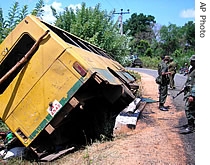2006年VOA标准英语-Landmine Monitor Reports Dramatic Progress(在线收听)
By Ron Corben
Bangkok
13 September 2006
The International Campaign to Ban Landmines reports dramatic progress in de-mining around the world. But landmines still inflict a terrible toll in 58 countries worldwide, says the campaign group in its annual survey that was released in Geneva on Wednesday. Both state and non-state armed groups in Southeast and South Asia still use mines.
-----
 Soldiers patrol near a bus overturned by a landmine blast in Kabithigollewa, about 210 kilometers northeast of Colombo, Sri Lanka (file photo) |
||
Casualties from mines and explosive remnants rose 11 percent to more than 7,328, a number the report admits is probably less than half the real total. The highest number of casualties, more than 1,100, was recorded in Colombia.
Thai Deputy Prime Minister Chidchai Wannasathit said at the report's launch in Bangkok that despite efforts to stop landmine use and production, mines keep killing.
"Landmines are an especially evil form of warfare," he said. "They kill indiscriminately, regardless of age, gender, nationality. Landmines can continue to kill long after the conflict ends."
The military powers of China, India, Pakistan, Russia and the United States are among those states that have not yet signed up to the 1997 Mine Ban Treaty.
Landmine clearance progressed in 2005, however, says Stuart Maslen, chief editor of the mine monitoring report.
"A total of more than 740 square kilometers were returned for use by mine action programs around the world," he added. "That is the biggest single annual de-mining total ever recorded."
More than 470,000 landmines were removed, thanks to better identification of areas suspected of carrying mines. De-mining has continued in Afghanistan, for example, despite increased security risks, the death of eight de-miners, and funding shortfalls.
Mr. Maslen says the use of antipersonnel mines remains a key concern. Three governments use antipersonnel mines - the Russian Federation, Burma, and Nepal - as do insurgent groups in India, Nepal, Pakistan and Sri Lanka.
"We condemn all use of antipersonnel mines, whether by governments or armed opposition groups, but it is particularly disappointing that governments despite the existence of the treaty, despite the political imperatives continue to use these weapons," he said.
In Burma, both the ruling military and ethnic armies fighting the government use antipersonnel mines extensively, the report said. Thai senator, Kraisak Choonhavan, agrees that Burma is a critical case in Southeast Asia.
"Burma is probably the most dangerous country, the most contaminated country in this region, equal to the places like Afghanistan," he said. "Along the Thai Burma border the mining of antipersonnel mines has not decreased at all. It has increased."
Meanwhile, Thailand's mine clearance has slowed and is expected to fail to clear all mines by the target of 2009.
Total funding for anti-mining work fell six percent in 2005. The United States is the largest contributor to global mine action providing almost $82 million to the $376 million funding program. Other major contributors include the European Commission, Japan, Norway and the United Kingdom.
Mr. Maslen says mine-affected states should commit more funds to the fight.
"Ultimately it is the responsibility of the country on whose territory contamination needs to deal with the problem," he added. "And we call upon all the states to do more using their own resources."
Landmine campaigners say continued funding is necessary to free all countries of mines by the end of 2010.